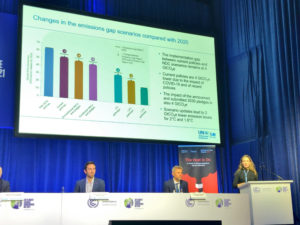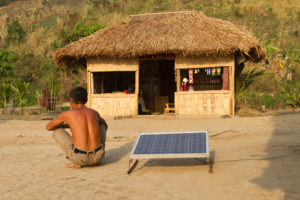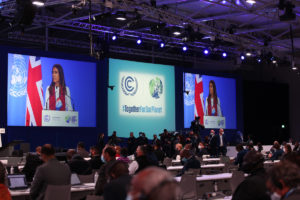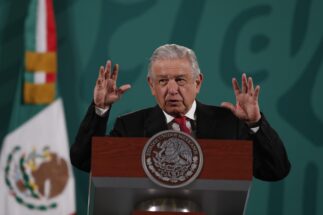In late October this year, just before the start of COP26, the UN Environment Programme (UNEP) calculated that the world is on its way to a catastrophic 2.7-degree Celsius temperature rise by the end of this century, even if all countries deliver on their pledges for climate action. Since then, several countries including India and Pakistan have announced new commitments to limit their emissions.
But these additional pledges are not enough, UNEP executive director Inger Andersen told delegates at COP26 in Glasgow on 9 November. “Frankly, it’s an elephant giving birth to a mouse,” she declared at a panel discussion during the ongoing UN climate summit.
The difference between the cut in emissions needed to stay on track to the goals of the Paris Agreement on the one hand and the trajectory of emissions cuts based on current pledges on the other is known as the ‘emissions gap’. The UNEP Emissions Gap Report 2021 released in October was the 12th annual report that provides an overview of the gap between what the science demands and the current political ambition.
As negotiations in Glasgow remain stalled over the question of financing from developed countries for climate action in developing nations, Andersen said there was a “leadership gap on top of the emissions gap”. She explained that the pledges made when the Paris Agreement was signed in 2015 would – if delivered upon – shave 7.8% of emissions from the business-as-usual scenario. “Now, it is 8%, whereas we need a 55% reduction by 2030 if we are to keep to the 1.5C goal.” The 1.5C goal is the aspirational target of the Paris Agreement, to keep average global temperature rise compared with pre-industrial times within a 1.5C ceiling this century.
What we need between now and 2030 is to halve our emissionsInger Andersen, UNEP
In her address at Glasgow, Andersen was also strongly critical of the ‘net zero’ pledges made by 130 countries, which declare a year by which a country’s greenhouse gas emissions will be matched by carbon that is removed from the atmosphere. She described the current promises as “generally vague and untransparent – some deal with greenhouse gases, some deal with carbon dioxide only”.
“What we need to see between now and 2030 is to halve our emissions,” said Anderson. “Climate change is here and now – and we’re now at 1.2 [degrees Celsius above average global pre-industrial temperatures]. When the IPCC released its report this year, we didn’t need graphs – what we saw out of our windows was enough. We’re seeing floods and storms already.”
Anne Olhoff, lead author of the UNEP Emissions Gap Report, said that experts had calculated the impact of the new pledges made since the report’s release, and found that they would only limit global temperature rise by 0.1C. “If all the NDCs [Nationally Determined Contributions] – unconditional and those conditional on receiving money from rich nations – are fully implemented, the overall effect will be to hold temperature rise down by 0.5C.”
Net-zero targets not credible, warn experts
The updated NDCs and net-zero pledges presented at COP26 have also been analysed by independent think tanks working under the umbrella of Climate Action Tracker. At a press conference at COP26, Claire Stockwell, senior climate policy analyst at Climate Analytics – a member of the tracker – said: “India will reduce its emissions a little bit earlier than usual. Australia and Brazil have gone worse in their updates.” At the World Leaders Summit that kicked off this UN conference, Indian Prime Minister Narendra Modi pledged to raise renewable energy installed capacity from 450 to 500 gigawatts by 2030, and to reduce emissions by 1 billion tonnes this decade, among other promises.
Overall, “the emissions gap till 2030 is so huge that we don’t see any chance of sticking to the 1.5-degree ceiling,” veteran analyst Bill Hare said, joining the same press conference. “Net zero is just paying lip service to climate action,” Hare added.
“Not a single country has short-term policy for net-zero targets,” said Niklas Hohne of New Climate Institute, another member of the tracker. “So the net-zero target is not credible. In 2030 we will still emit roughly twice as much as we should if we want to be on the 1.5C pathway. The only way is to go into emergency mode – baby steps will not do.”
COP26 negotiations still stuck over finance
But even baby steps have been missing in the negotiating rooms in Glasgow in recent days, due to the worsening stalemate over finance. Developing countries are already incensed because developed countries have not kept their promise to provide USD 100 billion in climate financing per year by 2020. On top of that, rumours have been circulating in the conference corridors that the European Union is going back on its promise to dedicate 50% of its financial support to help developing countries adapt to the impacts of climate change.
The negotiations have now moved from bureaucrats to ministers. In his report on progress, conference president Alok Sharma’s statement on Tuesday read: “The time has now come to find political consensus on the areas of divergence and we have only a few days left… What has been collectively committed to goes some way, but certainly not all the way, to keeping 1.5C within reach.”
Bhupender Yadav, India’s environment minister, confirmed that negotiations were stuck over finance. “Developed countries are asking developing countries to come up with climate action plans. How will they do it in the absence of finance? And we’re not asking for charity. We’re asking developed countries to stick to their pledges under the polluter pays principle, which is fundamental to the UN Framework Convention on Climate Change.”









